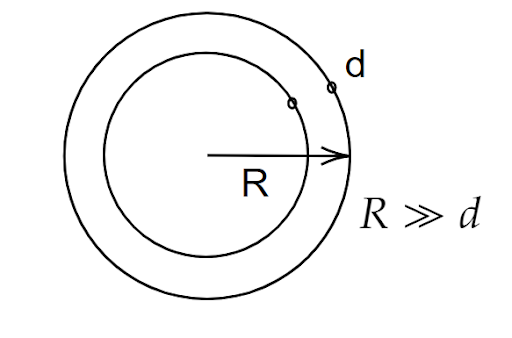
A soap bubble has radius R and thickness \[d( < < R)\] as shown in the figure. It collapses into a spherical drop. The ratio of excess pressure in the spherical drop to the excess pressure inside the bubble is \[{\left( {\dfrac{R}{{xD}}} \right)^{\dfrac{1}{3}}}\]. Find the value of x.

Answer
218.4k+ views
Hint: For a soap bubble, the pressurized bubble of air is contained within a thin, elastic surface of the liquid having a large volume and surface area. When the bubble bursts, it will form a number of spherical drops with lesser volume and surface area, the difference in pressure causes an audible sound.
Formula Used:
The equation of volume of a soap bubble is given by,
\[4\pi d{R^2} = \dfrac{4}{3}\pi {r^3}\]…………. (1)
Where, \[R\] is the radius of the soap bubble, \[d\] is the diameter of the soap bubble and \[r\] is the radius of the spherical drop.
Complete step by step solution:
To find the value of x we need to find the ratio of excess pressure.
The formula to find the ratio of excess pressure is given by,
\[{P_1} = \dfrac{{4S}}{R}\]..........(Excess pressure of the soap bubble initially)
\[{P_2} = \dfrac{{2S}}{r}\]..........(Excess pressure of the drop finally)
Now, \[\dfrac{{{P_2}}}{{{P_1}}} = \left( {\dfrac{{\dfrac{{4S}}{R}}}{{\dfrac{{2S}}{r}}}} \right)\]
\[\dfrac{{{P_2}}}{{{P_1}}} = \dfrac{R}{{2r}}\]
By rearranging the equation (1), the value of r will be written as,
\[r = {\left( {3{R^2}d} \right)^{\dfrac{1}{3}}}\]
Put the value of r in equation (2) then we get,
\[\dfrac{{{P_2}}}{{{P_1}}} = \dfrac{R}{{2r}}\]
\[\Rightarrow \dfrac{{{P_2}}}{{{P_1}}} = \dfrac{R}{{2{{\left( {3{R^2}d} \right)}^{\dfrac{1}{3}}}}}\\\]
\[\therefore \dfrac{{{P_2}}}{{{P_1}}} = \dfrac{R}{{{{\left( {24d} \right)}^{\dfrac{1}{3}}}}}\]
Therefore, the value of x is 24.
Note:Surface tension is defined as the property of any liquid by virtue of which it tries to minimize its surface area. The surface tension of water provides the necessary wall tension for the formation of the water bubbles. This tendency to minimize the tension on the walls pulls the bubbles into spherical shapes.
Formula Used:
The equation of volume of a soap bubble is given by,
\[4\pi d{R^2} = \dfrac{4}{3}\pi {r^3}\]…………. (1)
Where, \[R\] is the radius of the soap bubble, \[d\] is the diameter of the soap bubble and \[r\] is the radius of the spherical drop.
Complete step by step solution:
To find the value of x we need to find the ratio of excess pressure.
The formula to find the ratio of excess pressure is given by,
\[{P_1} = \dfrac{{4S}}{R}\]..........(Excess pressure of the soap bubble initially)
\[{P_2} = \dfrac{{2S}}{r}\]..........(Excess pressure of the drop finally)
Now, \[\dfrac{{{P_2}}}{{{P_1}}} = \left( {\dfrac{{\dfrac{{4S}}{R}}}{{\dfrac{{2S}}{r}}}} \right)\]
\[\dfrac{{{P_2}}}{{{P_1}}} = \dfrac{R}{{2r}}\]
By rearranging the equation (1), the value of r will be written as,
\[r = {\left( {3{R^2}d} \right)^{\dfrac{1}{3}}}\]
Put the value of r in equation (2) then we get,
\[\dfrac{{{P_2}}}{{{P_1}}} = \dfrac{R}{{2r}}\]
\[\Rightarrow \dfrac{{{P_2}}}{{{P_1}}} = \dfrac{R}{{2{{\left( {3{R^2}d} \right)}^{\dfrac{1}{3}}}}}\\\]
\[\therefore \dfrac{{{P_2}}}{{{P_1}}} = \dfrac{R}{{{{\left( {24d} \right)}^{\dfrac{1}{3}}}}}\]
Therefore, the value of x is 24.
Note:Surface tension is defined as the property of any liquid by virtue of which it tries to minimize its surface area. The surface tension of water provides the necessary wall tension for the formation of the water bubbles. This tendency to minimize the tension on the walls pulls the bubbles into spherical shapes.
Recently Updated Pages
Two discs which are rotating about their respective class 11 physics JEE_Main

A ladder rests against a frictionless vertical wall class 11 physics JEE_Main

Two simple pendulums of lengths 1 m and 16 m respectively class 11 physics JEE_Main

The slopes of isothermal and adiabatic curves are related class 11 physics JEE_Main

A trolly falling freely on an inclined plane as shown class 11 physics JEE_Main

The masses M1 and M2M2 M1 are released from rest Using class 11 physics JEE_Main

Trending doubts
JEE Main 2026: Application Form Open, Exam Dates, Syllabus, Eligibility & Question Papers

Derivation of Equation of Trajectory Explained for Students

Hybridisation in Chemistry – Concept, Types & Applications

Understanding the Angle of Deviation in a Prism

Understanding Collisions: Types and Examples for Students

Understanding Atomic Structure for Beginners

Other Pages
JEE Advanced Marks vs Ranks 2025: Understanding Category-wise Qualifying Marks and Previous Year Cut-offs

Units And Measurements Class 11 Physics Chapter 1 CBSE Notes - 2025-26

NCERT Solutions For Class 11 Physics Chapter 8 Mechanical Properties Of Solids

Motion in a Straight Line Class 11 Physics Chapter 2 CBSE Notes - 2025-26

NCERT Solutions for Class 11 Physics Chapter 7 Gravitation 2025-26

How to Convert a Galvanometer into an Ammeter or Voltmeter




